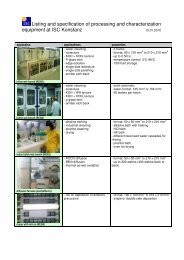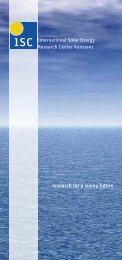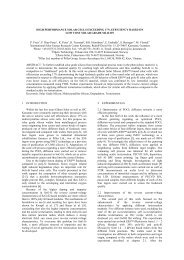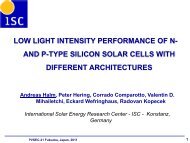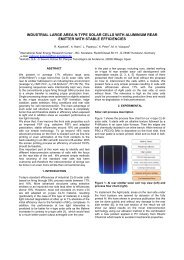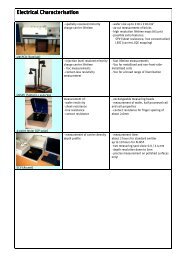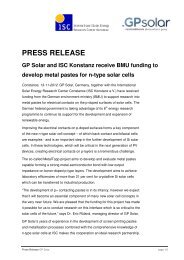FoXy Development of Solar-Grade Silicon Feedstock ... - ISC Konstanz
FoXy Development of Solar-Grade Silicon Feedstock ... - ISC Konstanz
FoXy Development of Solar-Grade Silicon Feedstock ... - ISC Konstanz
Create successful ePaper yourself
Turn your PDF publications into a flip-book with our unique Google optimized e-Paper software.
<strong>FoXy</strong>-DEVELOPMENT OF SOLAR-GRADE SILICON FEEDSTOCK FORCRYSTALLINE WAFERS AND CELLS BY PURIFICATION AND CRYSTALLISATIONM. Di Sabatino 1 , E.J. Øvrelid 1 , R. Kopecek 2 , S. Binetti 3 , V.D. Mihailetchi 4* , L. Geerligs 4 , A.N. Værnes 11SINTEF Materials and Chemistry, 7465 Trondheim, NORWAY2 <strong>ISC</strong>, <strong>Konstanz</strong>, GERMANY3UNIMIB, Milan, ITALY4 ECN, Petten, THE NETHERLANDSCorresponding author’s e-mail: marisa.di.sabatino@sintef.noABSTRACTThis work reports on the results obtained in the EU project<strong>FoXy</strong> (contract nr SES6-019811). <strong>FoXy</strong> has been carried outin the 6 th Framework Program in the Sustainable EnergySystems. It consists <strong>of</strong> a Europe-wide consortium <strong>of</strong> small andmedium size enterprises, research institutes and universities.The project has aimed at developing cleaning andcrystallisation processes for metallurgical SoG-Si feedstock,optimize associated cell and module processes, and setparameters for these types <strong>of</strong> feedstock. The major goals <strong>of</strong>the project have been: (i) achieve a significant cost reductionthrough more efficient cleaning processes for raw materials,(ii) secure high volume production <strong>of</strong> SoG-Si, (iii) developrecycling techniques for end-<strong>of</strong>-life products, (iv) shorten theenergy payback time significantly, (v) manufacture wafers ona large-scale industrial production line 150x150mm 2 aiming at16-17% cell efficiency with increased yield. This worksummarizes the highlight results <strong>of</strong> this three-year project.Keywords: <strong>Silicon</strong>, <strong>Feedstock</strong>, <strong>Solar</strong> cell, EfficiencyINTRODUCTION<strong>FoXy</strong> is a R&D project which aims at developing refining andcrystallisation processes for metallurgical SoG-Si feedstock,optimise associated cell and module processes, and setparameters for these types <strong>of</strong> feedstock.Under the realistic assumption that Si-wafer based PVmodules will dominate the market in the coming decade, the<strong>FoXy</strong> partnership has focused on the need <strong>of</strong> the PV marketfor low price and high quality solar grade silicon (SoG-Si)feedstock by:1. Further developing and optimising refining, purification,and crystallisation processes for metallurgical SoG-Sifeedstock, as well as for recycled n-type electronic gradeSi.2. Optimising associated cell and module processes.3. Setting input criteria for metallurgical and electronic n-type silicon to be used as raw materials for SoG-Sifeedstock.4. Transferring the technology from laboratory to industrialpilot tests.1. Achieve a significant cost reduction (down to 15€ per kg)through more efficient cleaning processes for rawmaterials.2. Secure high volume production <strong>of</strong> SoG-Si.3.4.Develop recycling techniques for end-<strong>of</strong>-life products.Shorten energy payback time to six months.5. Manufacture wafers on a large-scale industrialproduction line 150x150mm 2 aiming at 16-17% cellefficiencywith increased yield.The achievement <strong>of</strong> these aims allows the PV industry tostrengthen its position on the world market and fulfil the EUpolicy targets. The project has had a total budget <strong>of</strong> 4.7 M€, <strong>of</strong>which 2.7 M€ has been the requested EC contribution.A schematic structure <strong>of</strong> the project is shown in Figure 1. Theproject has been subdivided into the following tasks:WP1 - <strong>Feedstock</strong> via direct routeWP2 -Refining <strong>of</strong> highly doped feedstock and production<strong>of</strong> n-ty pe ingotsWP3 -Electrochemical refining <strong>of</strong> metallurgical feedstockWP4 -Material characterisationWP5 -Cell process optimisationWP6 -Modules and Recycling ‘end <strong>of</strong> life’WP7-Integration &ExploitationSINTEF has been coordinator for the project. The <strong>FoXy</strong>consortium has consisted <strong>of</strong> 11 partners, divided in:• Industry partnersDeutsche <strong>Solar</strong> (DE), Is<strong>of</strong>oton (ES), FESIL (NO),PILLAR (UA), SUNERGY (NL), ScanArc (SE)• UniversitiesNTNU (NO), UNIMIB (IT)• Research InstitutesECN (NL), <strong>ISC</strong> (DE), SINTEF (NO)The <strong>FoXy</strong> project started on January 1 st , 2006 and has beenrunning for 36 months. During this period, the project hasachieved important results. Among these, new feedstockprocessing routes have been investigated, refining techniqueshave been developed and a new passivation process has beenpatented, etc. In this work, we present and summarize some <strong>of</strong>themajor results from the subprojects WP4 and WP5.The overall objectives <strong>of</strong> the <strong>FoXy</strong> project have been:* Presently at <strong>ISC</strong>, <strong>Konstanz</strong>, GERMANY1
M. Di Sabatino, E. J. Øvrelid, R. Kopecek, S. Binetti, V.D. Mihailetchi, L.Geerligs, A. N. WærnesWP2: Cleaning &Refining HDNWP1: Cleaning & Refining DMRWP3: ElectrochemicalRefiningDeutsche <strong>Solar</strong>Highly dopedn-type wasteScanA /SUNSOLSILC feedstockSINTEF/FesilRecycled SiScanA /SUNSOLSILCfeedstockFesilMG SiproductionDeutsche <strong>Solar</strong>n-type purification inpilot equipmentDeutsche <strong>Solar</strong>Bridgman crystallisation(large scale)WP4:MaterialCharacterisationSINTEFSmall scale purificationFesilPilot scale purificationPillarCzcrystallisationSINTEFSIMS, LECO analysisECNICP-AES, IR, lifetime analysisNTNU GD-MS, PVScanSINTEFModellingSINTEFBridgman crystallisation(small scale)NTNU, SINTEFSINTEF<strong>ISC</strong>lifetimeUMIBPL, EBIC, IR, SEMElectrochemical refiningBridgman crystallisation(small scale)WP7:Integration&exploitationWP5:CelloptimisationP-typecellprocessIs<strong>of</strong>oton<strong>ISC</strong>ECNindustrial pilothigh efficiency baselineindustrial baselineN-typecellprocessIs<strong>of</strong>oton<strong>ISC</strong>ECNindustrial pilothigh efficiency baselineindustrial baselineCharacterisationUNIMIB<strong>ISC</strong>ECNPL, EBIC,IR, SEMlifetime, IV/SPR, IR, thermogr.lifetime, IV/SPR, FTIR, CoReIncreasedyield<strong>ISC</strong>ECNmech. stability, MIRHP,tube furnaceRPECVD, belt furnace gettWP6:Modules & RecyclingIs<strong>of</strong>otondemo module, n-type module recyclingECNLCAFigure 1: Schematic structure <strong>of</strong> the <strong>FoXy</strong> project.RESULTSDifferent types <strong>of</strong> silicon ingots for solar cells havebeen produced and studied within the <strong>FoXy</strong> project.Table 1 summarizes some <strong>of</strong> these ingots.Table 1. List <strong>of</strong> the ingots made in the <strong>FoXy</strong> project,characterized and reported in this work.Ingot Crys. Type <strong>Feedstock</strong>FS1 mc p-n SoG-Si without filtrationFP1 p Cz-Si +10%SoGFP2 p (ref) 100%EG+BFP6 Cz n Cz-Si+10%SoGFP7n (ref) 100%EG+PFS9 p 10%SOLSIC*-Si +BFS10 mc p 25%SOLSIC*-SiFS11 p (ref) Reference (100% EG)+B+PF1 p Off-cuts (Uncompensated)F2 mc p-n Off-cuts (Compensated)F3p-n Off-cuts (Highlycompensated)* Solsic process- ref [1]The feedstock to produce the ingot FS1 was made bycarbothermal reduction <strong>of</strong> very pure quartz and carbon (directroute). This process results in an upgraded metallurgical gradesilicon (UMG-Si) which features lower energy consumptionand higher purity compared to conventional metallurgical Si,but has to be further purified to satisfy the requirements forthe production <strong>of</strong> efficient solar cells. Ingot FS1 was grown ona directional solidification (DS) pilot-scale furnace. IngotsFS9, FS10 and FS11 were made with a mixture <strong>of</strong> feedstockfrom the Solsic process [1] and commercially availablepolysilicon. They were also grown in a DS pilot-scale furnace.Ingots FP1, FP2, FP6 and FP7 were grown in a Czochralskifurnace using a mix <strong>of</strong> 10% <strong>of</strong> SoG-Si feedstock from directcarbothermal reduction and 90% <strong>of</strong> pure electronic gradesilicon. FP1 and FP2 were p-type (target resistivity 2Ωcm),while FP6 and FP7 were n-type. FP6 had resistivity in therange 0.5 - 10 Ωcm (larger range due to compensation), whileFP7 had 2-3 Ωcm. After crystallization the ingots were cutinto around 1200 wafers (125x125 mm 2 ) <strong>of</strong> 200μm thickness.Ingots F1, F2 and F3 were grown from <strong>of</strong>f-cut materials in aDS industrial furnace. In this case, three levels <strong>of</strong>compensation were investigated and compared.For each ingot, chemical composition, resistivity and minoritycarrier lifetime were measured. The lifetime <strong>of</strong> the as-grownmaterial was
36μs) was higher than in the compensated ingots F2 (max25μs) and F3 (max 17μs).Ingot FS1 has the highest amount <strong>of</strong> impurities among theingots investigated. The distribution <strong>of</strong> B, P, Al and Fe alongthe ingot height is shown in Figure 3. Also the measureddissolved oxygen and oxygen precipitates density are veryhigh. Therefore, this ingot has the lowest lifetime. Optical,chemical and electrical characterization <strong>of</strong> this ingot has beenreported [2,3].As expected and as shown in Figure 4, the resistivitydistributions <strong>of</strong> ingot F1 (no compensation) and F2 (weakcompensation) are quite flat, whereas there is a strong increasetowards the top <strong>of</strong> the ingot in the case <strong>of</strong> F3, due to the strongcompensation <strong>of</strong> this ingot.diffusion length <strong>of</strong> the minority charge carriers. More detailson the characterization and solar cell properties <strong>of</strong> this ingothave been reported [4].resistivity [cm]2015105F1: uncompensatedF2: compensatedF3: strongly compensated80706050FS11FS09FS1000 50 100 150 200 250 300 350 400wafer position from bottomFigure 4: Lifetime <strong>of</strong> as-grown and after cell process forwafers from ingot FP1. (µs)403020100wafer number180160140120as grownafter cell processFigure 2: Lifetime <strong>of</strong> ingots FS9, FS10 and FS11.lifetime [s]100806040200top0 200 400 600 800 1000 1200bottomFigure 5: Resistivity measurements for ingots F1, F2 and F3.Figure 3: Chemical concentration <strong>of</strong> the B, P, Al and Fefor ingot FS1 as measured by GDMS.For all ingots, except FS1, it was shown that solar cellprocessing can give conversion efficiencies which arerelatively good. This is mostly due to removal <strong>of</strong> detrimentalimpurities during the P-gettering process. As an example, thelifetime <strong>of</strong> ingot FP1 increased from 10 μs to > 100 μs aftersolar cell processing, as shown in Figure 5.The solar cells made from the ingot FP1, on an untexturedfront surface and an industrial cell process, had efficiencies <strong>of</strong>up to 16.7% (17.1% on textured surface). In addition, as nodecrease towards ingot positions with higher resistivity andhigher compensation (low mobility <strong>of</strong> the majority chargecarriers) was visible, the high compensation <strong>of</strong> the samplesfrom the bottom <strong>of</strong> the ingot seems to have no detrimentalimpact on the cell efficiency and consequently on theIn addition to these results, it is worth mentioning that duringthe project period, baseline solar cell processes for both p- andn-type were developed. A new interconnection <strong>of</strong> p-type solarcells was patented by one <strong>of</strong> the project partners (<strong>ISC</strong><strong>Konstanz</strong>), as shown in Figure 6. Furthermore, a newpassivation process was developed. It consists <strong>of</strong> an ultrathinSiO2 layer formed by nitric acid oxidation <strong>of</strong> Si (NAOS)combined with SiNx to passivated n-type solar cells. Thisprocess as shown to give higher internal quantum efficiency<strong>of</strong> the solar cells (Figure 7) [5].Figure 6: Interconnection <strong>of</strong> p-type solar cells in astandard module (top) and innovative alternateinterconnection <strong>of</strong> p- and n-type solar cells in a pn-module(bottom) (pending patent by <strong>ISC</strong> <strong>Konstanz</strong>).3
M. Di Sabatino, E. J. Øvrelid, R. Kopecek, S. Binetti, V.D. Mihailetchi, L.Geerligs, A. N. WærnesFigure 7: Internal quantum efficiency <strong>of</strong> the n-type solar cellsmeasured for different passivation methods for boron emitter.Table 2 summarizes the best efficiencies <strong>of</strong> selected solar cellsproduced within the <strong>FoXy</strong> project. Note that no solar cellswere manufactured from ingots FS1 and F3 (Table 1).REFERENCES[1] E. J. Øvrelid, A. N. Wærnes, S. Santen, O. Raaness, E.Olsen, L.J. Geerligs, Proceedings <strong>of</strong> <strong>Silicon</strong> for the chemicalindustry, Trondheim, Norway, (July, 2006) 223-234.[2] H. Nordmark, M. Di Sabatino, M. Acciarri, J. Libal, S.Binetti, E.J. Øvrelid, J.C. Walmsley, R. Holmestad,Proceeding <strong>of</strong> 34 th IEEE conference (San Diego, USA, May2008).[3] S. Binetti, J. Libal, M. Acciarri, M. Di Sabatino, H.Nordmark, E.J. Øvrelid, J.C. Walmsley, R. Holmestad,Material Science and Engineering B, in press (2009).[4] J. Libal, S. Novaglia, M. Acciarri, S. Binetti, R. Petres, J.Aramughan, R. Kopecek, A. Prokopenko, J. Appl Physics,104 (2008).[5] V.D. Mihailetchi, Y. Komatsu, L.J. Geerligs, Appl. Phys.Letters, 92 (2008).Table 2. Best solar cell efficiencies achieved within the <strong>FoXy</strong>project.Ingot Crys. Type Size Best Eff. Ref.[mm 2 ] [%]FP1 p 156x156 16.5 <strong>ISC</strong>FP2 p (ref) 156x156 16.8 <strong>ISC</strong>FP6 Cz n 125x125 17.5 ECNFP7n (ref) 125x125 17.7 ECNFS9 p 125x125 15.8 <strong>ISC</strong>FS10 mc p 125x125 15.6 <strong>ISC</strong>FS11 p (ref) 125x125 15.7 <strong>ISC</strong>F1 p 156x156 15.0 <strong>ISC</strong>F2 mc p 156x156 14.5 <strong>ISC</strong>Note that the efficiency difference <strong>of</strong> about 1% absolutebetween p- and n-type Cz-Si cells is also due to anadvanced cell structure for n-type cells which wasdeveloped within the project leading to recordefficiencies for screen printed structures <strong>of</strong> 18.3% on n-type Cz-Si substrates [5].CONCLUSIONSThis work summarizes some <strong>of</strong> the major results achieved inthe European project <strong>FoXy</strong>.1. The results presented show that solar cells withgood efficiencies can be made with SoG silicon andblended feedstock. These achievements will securehigh volume production <strong>of</strong> SoG-Si for the PVindustry.2. Good efficiency solar cells can also be made fromrecycled <strong>of</strong>f-cut materials with significant costreduction.3. It has been shown that wafers on a large-scaleindustrial production line 150x150mm 2 with > 16%cell efficiency with increased yield can bemanufactured.ACKNOWLEDGEMENTSThe authors thank the <strong>FoXy</strong> consortium and Mr. AndreasPiontek (EU <strong>of</strong>ficer) for interesting discussion. The work wasfinanced by the EU project <strong>FoXy</strong> (contract nr SES6-019811).4


